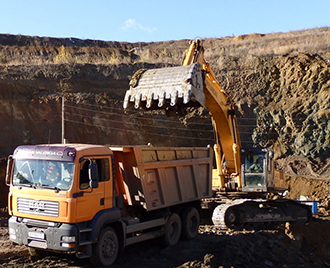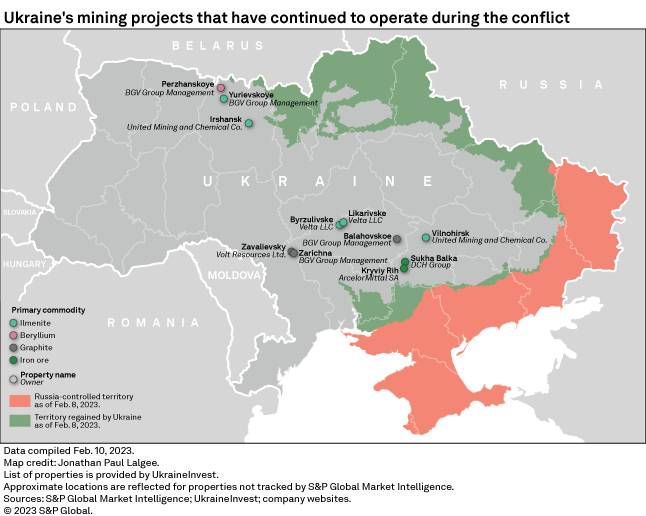S&P Global Offerings
Featured Topics
Featured Products
Events
S&P Global Offerings
Featured Topics
Featured Products
Events
S&P Global Offerings
Featured Topics
Featured Products
Events
Banking & Capital Markets
Economy & Finance
Energy Transition & Sustainability
Technology & Innovation
Podcasts & Newsletters
Banking & Capital Markets
Economy & Finance
Energy Transition & Sustainability
Technology & Innovation
Podcasts & Newsletters
S&P Global Offerings
Featured Topics
Featured Products
Events
21 Feb, 2023
By Anthony Barich
➤ Ukraine sources all of its iron ore imports from Europe, up from 45% before Russia's invasion.
 |
| UkraineInvest Executive |
Global metals markets continue to feel the ripple effects a year into the Russian war in Ukraine, given the wide-reaching sanctions, Russia's large nickel and aluminum production, and the conflict's role in exacerbating supply chain constraints.
Ukraine is one of the world's top 10 titanium producers, ships iron and steel products to Europe, and has ambitions to become a key supplier of the critical minerals Europe needs to meet its electrification targets and cut reliance on Russian energy.
Several mining and processing operations have remained open to support the local workforce and economy, but any significant buildout of Ukraine's metals and mining industry will have to wait out the war.
UkraineInvest, the government's investment promotion office, has sent Executive Director Sergiy Tsivkach to European investment conferences in recent months to attract interest in various industries with the potential to help rebuild the country.
S&P Global Commodity Insights interviewed Tsivkach by email on the current state of Ukraine's metals and mining sector and the challenges and opportunities around becoming a significant supplier of other commodities. The interview has been edited for clarity and length.
S&P Global Commodity Insights: A year into the war, how would you describe the state of Ukraine's metals and mining sector?
.
|
Sergiy Tsivkach:
Before the full-scale invasion by the Russian Federation, the mining and metal complex of Ukraine provided about 10% of gross domestic product and 33% of exports.
On an annual basis, the export of titanium ores from Ukraine in October 2022 decreased by 16.7% in physical terms and by 11.6% in monetary terms. In January-October 2022, Ukrainian enterprises exported 273,400 tonnes of titanium ores, 38.9% less than in the prior-year period. The main consumers of Ukrainian titanium ores in January-October 2022 were the Czech Republic (49.62% in monetary terms), the U.S. (12.27%) and Poland (7.27%).
The domestic iron and steel sector is export-oriented, so the blockade of Ukraine's Black Sea ports by the Russian military fleet strongly affected the industry.
In 2022, Ukrzaliznytsia [Ukrainian Railways] reduced the transportation of iron and manganese ores to 31.7 million tonnes, which is 45.9 million tonnes, or 59.2%, less than 2021. The transportation of ferrous metals in 2022 decreased by 57.8% compared with 2021 to about 9.2 million tonnes.
Since the start of the war, Ukrainian steelmakers have experienced difficulties in shipping finished products for export. The blockade of the ports forced product shipments to reorient exclusively to the railway. Thus, logistics costs have increased several times, and the delivery time has increased significantly. Border crossings could not cope with such an influx of railcars, so railcars with products stood in queues for weeks.
After the opening of the grain corridor in July 2022, the situation has improved but remains tense. The share of EU countries in the export of Ukrainian iron and steel increased from 34% in the prewar months to 69% in April-September 2022. A hundred percent of iron ore supplies come from European countries; before the war, their share was only 45%. The main export destinations of Ukrainian iron and steel products became Poland, Romania and Slovakia, which are used as transit hubs for further transportation by sea or rail.
What are Ukraine's top mineral resources?
Ukraine is one of the top 10 in proven titanium reserves and provides 7% of world production. About 28 fields and more than 30 ore occurrences have been discovered so far. Currently, titanium is mined at six heavy mineral sands fields, with almost 900,000 tonnes per year of concentrate produced.
Ukraine is also the world's sixth largest in iron extraction, seventh in manganese and kaolin extraction, and 11th in zirconium silicate.
 |
| Volt Resources' Zavalievsky graphite mine in Ukraine, which restarted mid-2022. |
You have stated the intention for Ukraine to become a major graphite supplier. Aside from the war, what are the greatest challenges to achieving this?
The Zavalievsky deposit is considered one of the largest in Europe. Considering Ukraine's recorded graphite reserves are about 13.7 million tonnes, the country has the potential to increase production of graphite several times. That, in turn, will make it possible to increase the export of graphite raw materials and to attract investments to Ukraine. The Ukrainian mining industry needs investments and the involvement of new efficient mining technologies.
What other mineral resources hold potential for Ukraine, and what is being done to facilitate this?
Although copper is not produced in Ukraine, there are nearly 150 copper occurrences in the Rivne, Zhytomyr and Volyn regions. Developing them could become an attractive investment once the war ends.
Lithium is not mined in Ukraine, though there are three explored fields with lithium oxide content of 1.1% to 1.3%, with one promising area for further exploration and also several lithium occurrences.
There are 12 silicate nickel fields in Ukraine that contain cobalt as a coproduct. The cobalt reserves are up to 9,000 tonnes, with estimated reserves of 215,000 tonnes for nickel, 8,800 tonnes for cobalt and 453,000 tonnes for chromium oxide. In measured and indicated resources, there are also 3.1 million tonnes of chromium oxide and 95,000 tonnes of copper.
Ukraine intends to attract investors to the development of the specified types of minerals by placing deposits on transparent auctions.

S&P Global Commodity Insights produces content for distribution on S&P Capital IQ Pro.
Evaluate the impact of the Russia-Ukraine conflict on the metals market with our essential mining intelligence. Learn more >
